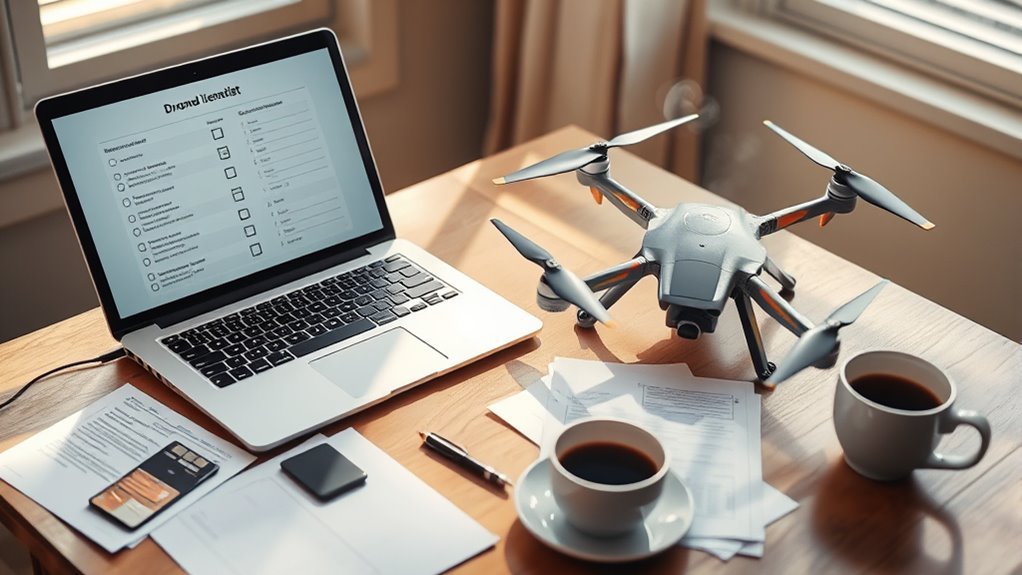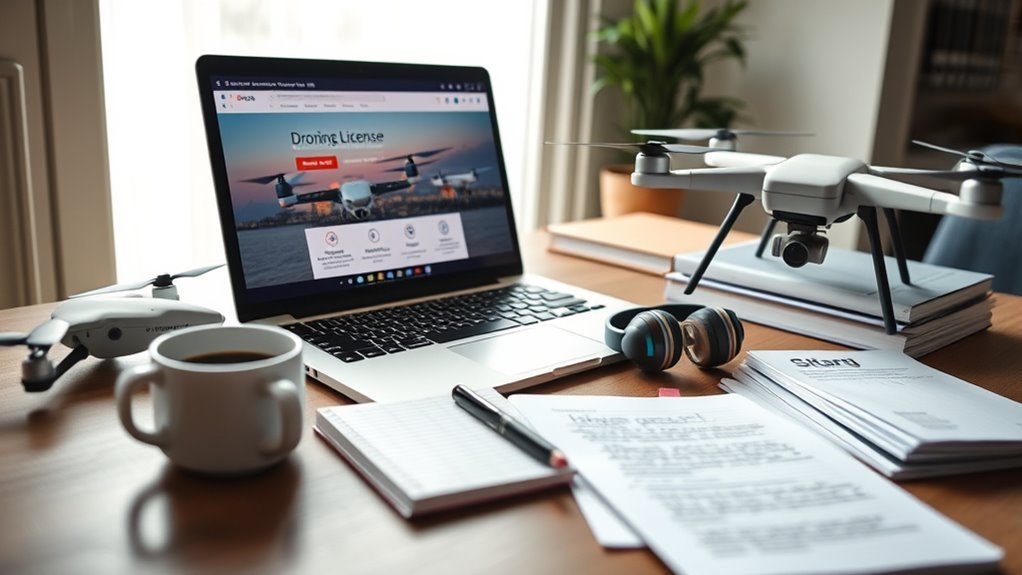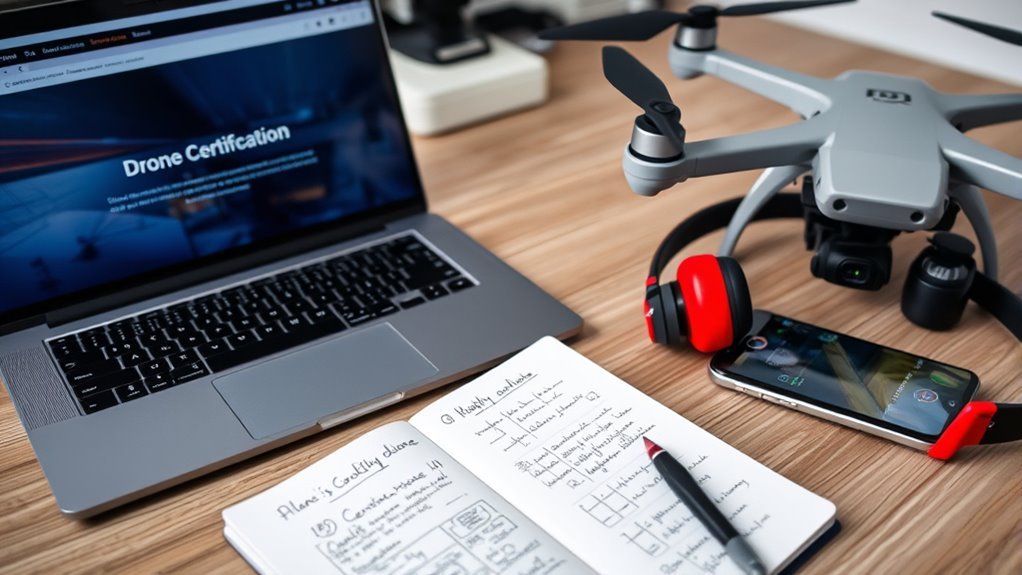To obtain a drone license, start by understanding regulations and compliance. Choose a drone that fits your needs and budget. Prepare for the FAA Part 107 exam by studying airspace classifications and weather impacts. Register your drone on the FAA website, guaranteeing all documents and fees are ready. Finally, take the FAA Part 107 exam and maintain your license by staying compliant with regulations. Learn more about critical steps and ongoing requirements to guarantee successful drone operations.
Understanding Drone Regulations and Requirements

Understanding drone regulations and requirements is vital for anyone looking to operate a drone legally and safely. You need to familiarize yourself with drone airspace regulations, which dictate where you can and can’t fly. Most importantly, it’s essential to identify legal flight zones, as flying in restricted areas can lead to hefty fines or legal action. Additionally, flying near airports and government buildings is strictly prohibited without authorization. You should also be aware of altitude limits and no-fly zones, including near airports and sensitive locations. Regularly checking for updates to regulations will help guarantee compliance and maintain your freedom to fly. By staying informed and adhering to these rules, you’ll not only safeguard your rights as a drone operator but also contribute to the safety of others in shared airspace. Additionally, understanding NDAA compliance can enhance your operational resilience and ensure you are sourcing drones from vetted suppliers.
Choosing the Right Drone for Your Needs

When choosing the right drone, it’s crucial to first determine your flight purpose, whether for photography, surveying, or recreational use. Next, consider the camera quality you need, as this can greatly impact the results of your projects. Finally, evaluate your budget constraints to guarantee you select a drone that meets your needs without exceeding your financial limits. For instance, drones like the DJI Air 2S and Autel Robotics EVO Lite+ offer high-quality 1-inch CMOS sensors that significantly enhance image quality.
Determine Flight Purpose
What’s your primary goal for flying a drone? Understanding your flight purpose is essential for selecting the right drone. Whether you’re aiming for commercial applications or recreational usage, your choice will affect performance, regulations, and licensing requirements. Here are some key considerations:
- Commercial Applications: Are you planning to capture aerial photos, inspect properties, or conduct surveys?
- Recreational Usage: Do you want to fly for fun, take videos, or participate in racing?
- Budget: What’s your financial limit for purchasing and maintaining the drone?
- Skill Level: Are you a beginner or an experienced pilot?
Consider Camera Quality
Choosing the right drone often hinges on the quality of its camera, especially if your goals include capturing stunning visuals or conducting detailed inspections. You’ll want to examine various camera features like resolution, lens type, and zoom capabilities. High-resolution cameras deliver clearer images, while wide-angle lenses can capture more expansive scenes. Additionally, consider the importance of image stability; drones with advanced stabilization systems help eliminate shaky footage, ensuring professional-quality results. If you’re planning to use your drone for commercial purposes, regulatory compliance regarding camera specifications may also come into play. Ultimately, a drone equipped with superior camera features and reliable image stability will empower you to achieve your creative and operational aspirations.
Evaluate Budget Constraints
While evaluating your options, it’s crucial to take into account your budget constraints, as they can greatly influence the type of drone you can purchase. A thorough cost analysis will help you identify suitable funding options that align with your financial capacity. To make an informed decision, consider the following:
- Drone Type: Determine if you need a recreational or professional-grade drone.
- Features: Assess required specifications like battery life, range, and camera capabilities.
- Maintenance Costs: Don’t forget to factor in ongoing expenses for repairs and upgrades.
- Insurance: Consider the costs associated with liability and damage coverage.
Preparing for the FAA Part 107 Exam

As you prepare for the FAA Part 107 exam, it is vital to understand the regulatory framework governing drone operations. Familiarize yourself with study materials that cover airspace classifications, weather, and regulations. Practice tests are invaluable for evaluating your knowledge and identifying areas needing improvement. Additionally, understanding sanitization performance can be beneficial for those interested in commercial drone applications. Weather conditions, including temperature effects, can significantly impact both flight safety and battery efficiency.
| Topic | Importance |
|---|---|
| Airspace Regulations | Critical for safe flights |
| Weather Conditions | Affects flight safety |
| Operational Limitations | Know your drone’s limits |
| Emergency Procedures | Important for safety |
| Preflight Checklist | Guarantees thorough preparation |
Registering Your Drone
Registering your drone is an important step in ensuring compliance with FAA regulations. This drone registration process is straightforward but requires specific steps and documentation. Here’s what you need to prepare:
- A valid email address for registration confirmation
- Your drone’s make, model, and serial number
- Payment information for the registration fee
- Proof of identity, such as a government-issued ID
Once you gather the required documentation, visit the FAA’s registration website. You’ll complete the online form, pay the fee, and receive your registration number. Remember, maintaining compliance not only protects your freedom to fly but also contributes to the safety of the airspace. Don’t skip this significant step in your drone ownership journey!
Taking the FAA Part 107 Exam
To operate a drone commercially, you must pass the FAA Part 107 Exam, a vital step that demonstrates your knowledge of aviation regulations and safety protocols. Effective test preparation is important; familiarize yourself with the FAA’s study materials and consider taking a preparatory course. Use exam strategies like practice tests to identify weak areas and build confidence. Focus on key topics such as airspace classification, weather, and operational limitations. Remember, the exam consists of 60 multiple-choice questions, so time management is essential. Don’t rush—read each question carefully. Once you feel ready, schedule your exam at an FAA-approved testing center. Passing this exam not only grants you freedom to operate commercially but also guarantees you’re equipped to fly safely and responsibly.
Maintaining Your License and Staying Compliant
To maintain your drone license, you’ll need to focus on the renewal process and guarantee you’re aware of any regulatory updates. Staying informed helps you adhere to safety protocols, which is essential in avoiding penalties. Regularly checking the FAA website can keep you compliant and up-to-date.
License Renewal Process
While holding a valid drone license is essential for safe and legal operation, understanding the renewal process is equally important to guarantee compliance with regulations. To ascertain your license doesn’t face expiration, you’ll need to follow specific renewal requirements:
- Check expiration dates: Be aware of when your current license expires.
- Complete any necessary training: Stay updated on any required educational courses or tests.
- Submit your application: Confirm you fill out the renewal application accurately and submit it on time.
- Pay renewal fees: Be prepared to cover any associated fees to maintain your license.
Regulatory Updates Awareness
Staying updated on regulatory changes is crucial if you want to maintain your drone license and guarantee compliance. The drone industry is rapidly evolving, with regulations frequently updated to address new technologies and safety concerns. To make sure you’re always in the loop, subscribe to relevant newsletters, follow regulatory agencies on social media, and join online forums or communities focused on drone operations. Regularly check for compliance updates from the FAA or other governing bodies, as overlooking these changes could jeopardize your license. Additionally, consider attending workshops or webinars that focus on regulatory knowledge. By staying informed, you’ll not only protect your ability to operate freely but also contribute to a safer and more responsible drone community.
Safety Protocol Adherence
Adhering to safety protocols is essential not just for your own safety but also for maintaining your drone license and guaranteeing compliance with regulations. By following these guidelines, you can enhance drone safety and effectively manage risks:
- Always conduct pre-flight checks to verify your equipment is operational.
- Keep your drone within visual line of sight to avoid collisions.
- Adhere to local airspace regulations and restrictions.
- Monitor weather conditions to prevent flying in unsafe environments.
These practices aren’t just about compliance; they’re about fostering a culture of responsibility. By prioritizing safety, you protect your freedom to fly and contribute to a safer drone community. Remember, your license depends on ongoing adherence to these protocols, so stay informed and vigilant.
Frequently Asked Questions
How Long Does the Drone Licensing Process Take?
The drone licensing process typically varies, but you should expect several weeks for processing time after submitting your application requirements. Factors like application completeness and demand can influence how long it takes to receive your license.
Can I Fly My Drone at Night?
Yes, you can fly your drone at night, but you must adhere to night flying regulations. Confirm your drone meets specific lighting requirements to maintain visibility and comply with safety standards while enjoying your nighttime flying experience.
Are There Age Restrictions for Obtaining a Drone License?
Yes, there are age requirements for obtaining a drone license. Generally, you must be at least 16 years old. Youth eligibility exists, but parental consent might be required for those under 18 seeking a license.
What Happens if I Fail the FAA Part 107 Exam?
If you fail the FAA Part 107 exam, you can retake it after a waiting period. Utilize study resources to strengthen your knowledge, ensuring you’re well-prepared for the exam retake process and your future flights.
Can I Sell My Drone Footage Commercially Without a License?
You can’t sell your drone footage commercially without a license due to drone regulations. Operating for commercial use requires compliance with FAA rules, ensuring safety and accountability while enjoying the freedom of aerial creativity.

